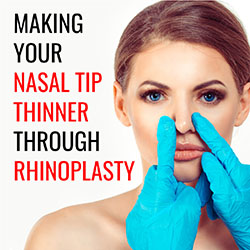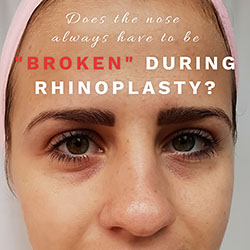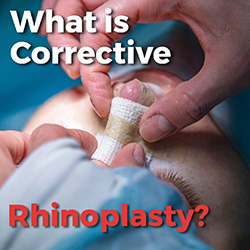Making Your Nasal Tip Thinner Through Rhinoplasty

Of all the concerns that patients have about their noses, two of the most common are 1) a hump visible from the profile view and 2) a wide tip. So thinning the tip is one of the most common goals of Rhinoplasty.
When you look at a face, more often than not, your attention may be directed to the nasal tip. In fact, how your nasal tip looks affect the aesthetics of your entire face. Changing the shape of the nasal tip is a powerful technique that can make subtle but definite changes in the nasal and facial appearance.
But before you decide on undergoing the procedure, here are the things that you should consider.
Do I need a Septoplasty for my Deviated Nasal Septum?

The nasal septum is just a wall or partition that is inside the nose dividing the air on the right side of the nose from the air on the left side. Of course the air comes together in the back of the throat and then goes down into the lungs. The septum is not visible from the outside and usually has nothing to do with the appearance of the nose from the outside. The main problem with a deviated septum is that it can cause airway (breathing) obstruction on one or both sides of the nose. It may be surprising thing to know that approximately 80% of the population of the United States has a deviation of their nasal septum. Fortunately, most people do not experience any breathing problems and require no treatment. In cases where the deviation causes breathing problems, a septoplasty can be performed to relieve the obstruction. As mentioned above, a deviated septum usually does not affect the appearance of the nose but there are cases where the deviation causes the nose to be crooked.
What is Nasal Tip Rotation?

We all know how important the nose is to an attractive face. First of all its central location makes the nose especially visible. But what makes an attractive nose? We may think that a particular nose is attractive but what catches our eye? What makes it attractive? It turns out that the length of the nose and the distance it sticks out (the projection) have to be in proportion. Once that happens the nose is almost magically transformed into one that is attractive. We all know how important the nose is to an attractive face. First of all its central location makes the nose especially visible. But what makes an attractive nose? We may think that a particular nose is attractive but what catches our eye? What makes it attractive? It turns out that the length of the nose and the distance it sticks out (the projection) have to be in proportion. Once that happens the nose is almost magically transformed into one that is attractive.
One characteristic shape that patients frequently want to be corrected is a “droopy nose”.
Does the nose always have to be “broken” during rhinoplasty?

People commonly fear having their nose “broken” during routine cosmetic or reconstructive nasal surgery. First of all, it is not really “breaking”; it is more like “cutting”, so it is much more precise than breaking, and is much less of a big deal than you might think. Secondly, like any maneuver during rhinoplasty, cutting the bone in order to narrow the upper portion of the nose is only performed when necessary. Not everyone needs it.
When does your nose need to be broken during rhinoplasty?
Understanding Teenage Rhinoplasty

Rhinoplasty or nose surgery has always been one of the most common cosmetic procedures. Recently, there has been a surge of interest in plastic surgery of the nose within the teenage population.
The nose is often a source of insecurity for people, but that is especially true for teenagers. Self-esteem is delicate during this critical phase of development. One comment from a peer can leave lasting scars. Some teens think that their lack of popularity is the result of a physical feature, such as the shape of their nose, even if that has nothing to do with it. And still, others feel frustrated with their noses even without the influence of social media or peer pressure. So what exactly is the difference between teenage rhinoplasty and adult nasal surgery?
What is Teenage Rhinoplasty?
Teenage rhinoplasty is the same as adult rhinoplasty except that it is performed on adolescents who may still be growing physically and are definitely still growing emotionally. The primary reason for plastic surgery on the nose in this age group is to improve the appearance (and the self-esteem) of the patients and in some cases to improve breathing at the same time.
Choosing Your Rhinoplasty Surgeon: Things You Should Ask

Every surgical procedure comes with risks and having an operation on your face is a big decision. As one of the most common cosmetic procedures, Rhinoplasty is no exception. Even if your surgeon is capable, you expose yourself to the possibility that something won’t be exactly right. That is why it is important to ask the right questions before choosing your Rhinoplasty surgeon.
Listed below are some of the questions that you should ask your plastic surgeon. Don’t be intimidated; an experienced surgeon has heard all these questions before and will be happy to address your concerns.
Questions you should ask your rhinoplasty surgeon:
- Do you specialize in the Face or do you specialize in the Breast and Body?
What is Corrective Rhinoplasty?

If you’ve ever seen an episode of a reality program on failed cosmetic procedures, you would know that one of the most common subjects is having bad nose jobs “fixed”.
What they really mean is “corrective rhinoplasty”. Corrective rhinoplasty, revision rhinoplasty, and secondary rhinoplasty are all names for the same thing; that is, they describe surgical procedures performed on noses that have undergone previous surgery.
Rhinoplasty is a surgical alteration of the bony and cartilaginous nasal architecture in order to improve the appearance, and often the function, of the nose. According to the 2020 survey of The Aesthetic Society (The American Society for Aesthetic Plastic Surgery) rhinoplasty is the 5th most common plastic surgery performed. It is also the most common plastic surgical procedure performed on teenagers.
Your Recovery Guide After a Rhinoplasty

Are you excited to see the results of your nose job? Curious if the road to recovery after having a rhinoplasty is difficult or painful? Well, here is your recovery guide for nasal surgery. Listed below are the things that you can expect and the steps that you should take to heal faster with minimum discomfort.
Follow the doctor’s advice
Although it is good to do research, it is always best to follow your surgeon’s advice. First of all, every surgeon has slightly different “rules” that he/she will want you to follow. Secondly, the recovery will vary slightly depending on exactly which maneuvers were performed. A procedure to reduce a hump will have a quicker recovery than, for example, a rhinoplasty in combination with a septoplasty in which multiple cartilage grafts were placed in the nose. In the old days, surgeons placed packing in the nose which was a source of discomfort but that is rare these days. The surgery takes from 1-3 hours and is really not very painful. Most patients do not require opioids during the recovery period.
Understanding Ethnic Rhinoplasty

Nose surgery or rhinoplasty is a procedure that includes reshaping or reconstructing your nasal cartilage and bone to improve your breathing or enhance the aesthetic appearance of your nose.
When getting a rhinoplasty, surgeons do their best to produce your ideal or desired look with natural-looking results. Historically, the ideal proportions of a nose were based on Caucasian features which are typically narrow and thin. If the same standards are applied to non-Caucasian people, the results may look unnatural or unattractive.